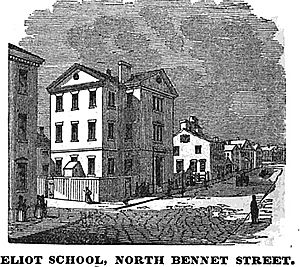Eliot School rebellion facts for kids
The Eliot School rebellion was an important event in the 1800s. It helped shape how religious lessons were taught in American public schools. This incident also led to the creation of many Catholic schools across the country.
The incident began on a Monday morning, March 7, 1859. A law in Massachusetts said that the Ten Commandments had to be recited in every classroom. Bible passages also had to be read aloud. On that day, a teacher at the Eliot School in Boston, Miss Sophia Shepard, asked ten-year-old Thomas J. Whall to recite the Ten Commandments. Thomas refused because he was Catholic. Miss Shepard insisted that the Commandments be recited from the Protestant King James Bible.
The next Sunday, at St. Mary's Parish Sunday School, Thomas Whall was among hundreds of boys. They heard Father Bernardine Wiget, a Jesuit priest, tell them not to say Protestant prayers. The church members passed a resolution. It said that children should be taught not to be ashamed of their religion. Father Wiget also said he would announce the names of any boys who recited the Protestant prayers at the Eliot School.
On Monday, March 14, Miss Shepard again asked Thomas Whall to recite the Commandments. He refused again. The assistant principal, McLaurin F. Cook, was called. The principal told all boys who would not recite the King James version to leave the school. About 100 boys left that day. Another 300 boys left the next day. Some boys came to school with copies of the Catholic Vulgate Commandments. They were willing to recite these, but they were not allowed into the school.
This event gained a lot of attention across the country. A complaint was made against Principal Cook by Thomas's father. However, the complaint was dismissed. The court decided that religious instruction was a proper part of public school teaching.
According to historian John McGreevy, this incident led to the creation of Catholic schools. This happened in Boston and all over the United States. In Boston, St. Mary's Parish started a primary school. It was for the boys who had left the Eliot School. This school was first called St. Mary's Institute. Later, it was named after Father Wiget. In the 1859-60 school year, 1,150 boys attended this new school.
Thomas J. Whall: A Key Student in the Rebellion
Quick facts for kids
Thomas J. Whall
|
|
|---|---|
| Born |
Thomas J. Whall
March 31, 1848 Kilkenney, Ireland
|
| Died | March 14, 1911 (aged 62) Reading, Massachusetts
|
| Known for | Eliot School rebellion |
Thomas J. Whall (born March 31, 1848, in Kilkenny, Ireland – died March 14, 1911, in Reading, Massachusetts) was a Catholic student. He attended Boston's Eliot School. He was involved in the Eliot School rebellion. He was disciplined for not reading the Ten Commandments from the King James version.
Thomas Whall's family went to St. Mary's Roman Catholic Church. This church was in Boston's North End. This area had many Catholic families. Most lived in small apartments near the docks. On March 7, 1859, ten-year-old Thomas J. Whall refused to say the Ten Commandments. This was required by Massachusetts law for all public schools. Thomas said his father told him not to recite the Protestant version. Thomas's father and members of the school committee tried to find a solution. However, one committee member, Micah Dyer, was a supporter of the Know Nothing Party. He insisted that the state law be followed strictly.
Thomas Whall and his father made a complaint against Principal Cooke. The court supported Cooke's actions. This case gained a lot of attention. Seven Catholic schools sent messages of support to Thomas. These included the cathedral school of Covington, Kentucky. The cathedral school of Cincinnati, Ohio, sent him a gold watch case and later a gold-lined cup. As an adult, Thomas faced some challenges finding work.



